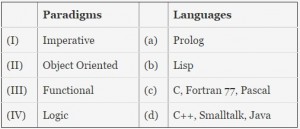Principles of Programming Languages
Question 11
The following program fragment is written in a programming language that allows variables and does not allow nested declarations of functions.
C
If the programming language uses static scoping and call by need parameter passing mechanism, the values printed by the above program are
global int i = 100, j = 5;
void P(x)
{
int i = 10;
print(x + 10);
i = 200;
j = 20;
print(x);
}
main()
{
P(i + j);
}
Question 12
The following program fragment is written in a programming language that allows variables and does not allow nested declarations of functions.
C
If the programming language uses dynamic scoping and call by name parameter passing mechanism, the values printed by the above program are :
global int i = 100, j = 5;
void P(x)
{
int i = 10;
print(x + 10);
i = 200;
j = 20;
print(x);
}
main()
{
P(i + j);
}
Question 13
The results returned by functions under value-result and reference parameter passing conventions
Question 14
What is printed by the print statements in the program P1 assuming call by reference parameter passing?
Program P1()
{
x = 10;
y = 3;
func1(y,x,x);
print x;
print y;
}
func1(x,y,z)
{
y = y+4;
z = x+y+z;
}
Question 15
Consider the following program
pascal
If the language has dynamic scoping and parameters are passed by reference, what will be printed by the program?
Program P2
var n: int:
procedure W(var x: int)
begin
x=x+1;
print x;
end
procedure D
begin
var n: int;
n=3;
W(n);
end
begin //beginP2
n=10;
D;
end
Question 17
What will be the output of the following pseudo-code when parameters are passed by reference and dynamic scoping is assumed?
a=3;
void n(x) {x = x * a; print(x);}
void m(y) {a = 1; a = y - a; n(a); print(a);}
void main() {m(a);}
Question 18
The attributes of three arithmetic operators in some programming language are given below.
Operator Precedence Associativity Arity + High Left Binary - Medium Right Binary * Low Left BinaryThe value of the expression 2 - 5 + 1 - 7 * 3 in this language is __________ ? Note : This question was asked as Numerical Answer Type.
There are 35 questions to complete.
Last Updated :
Take a part in the ongoing discussion
